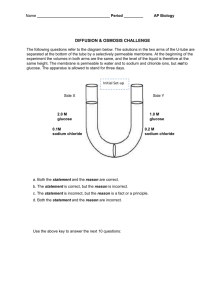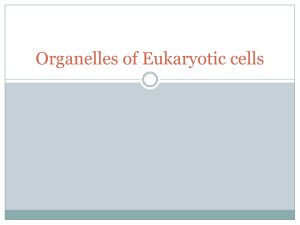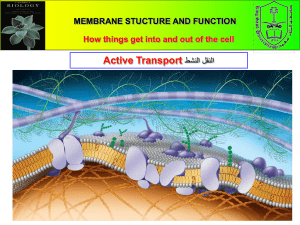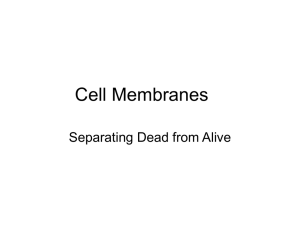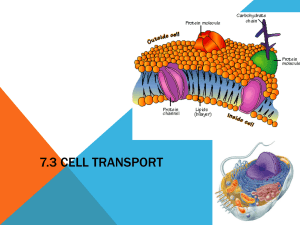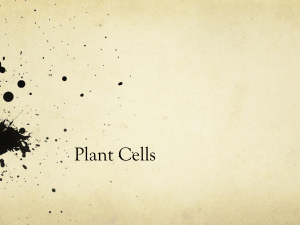CO2 would move across a plasma membrane more quickly than
advertisement
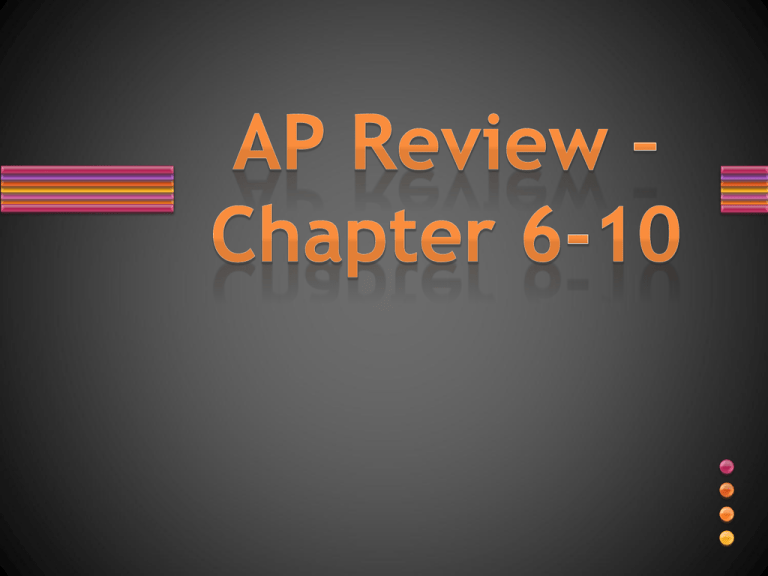
Match the organelle to the function. Cell Membrane Modify, package, and transport cell materials Endoplasmic Reticulum Provide cell with energy Mitochondria Contain cell contents, control cell traffic Lysosome Manufacture proteins and plasma membranes Golgi body Digest food molecules Unsaturated fatty acids keep a membrane more fluid at lower temperatures. Which of the following is most likely true of a protein that cotransports glucose and sodium ion into the intestinal cells of an animal? • a. The sodium ions are moving down their electrochemical gradient which glucose is moving up. • b. Glucose entering the cell along its concentration gradient provides energy for uptake of sodium ions against their electrochemical gradient. • c. Sodium ions can move down their electrochemical gradient through the cotransporter whether or not glucose is present outside the cell. • d. The cotransporter can also transport potassium ions. A cell has the following molecules and structures: enzymes, DNA, ribosomes, plasma membrane, and mitochondria. It could be a cell from • • • • A. a single celled prokaryotic organism B. a mutlicelled eukaryotic organism C. an animal only D. any kind of organism Which is the true statement? • A. Autotrophs, but not heterotrophs, can nourish themselves beginning with CO2 and inorganic nutrients. • B. Cellular respiration is unique to hetertrophs. • C. Only heterotrophs have mitochondria. • D. Heterotrophs require chemical compounds from the environment. An organism with a cell wall would most likely be unable to take in materials through • • • • A. diffusion B. osmosis C. active transport D. phagocytosis When electrons move closer to a more electronegative atom, the more electronegative molecule gets _____________ and the less electronegative molecule is _____________. Osmosis is the transport of a large organic molecule into or out of a cell. What happens to pyruvate in between glycolysis and the start of the Krebs/citric acid cycle? CO2 would move across a plasma membrane more quickly than glucose and K+. Model and explain how lipid molecules form a phospholipid bilayer. Which of the following is true of enzymes? • A. Enzymes increase the rate of chemical reaction by lowering activation energy barriers. • B. Nonprotein cofactors alter the substrate specificity of enzymes. • C. Enzyme function is independent of physical and chemical environmental factors such as pH and temperature. • D. Enzyme function is increased if the 3-D structure or conformation of an enzyme is altered. Large numbers of ribosomes are present in cells that specialize in producing which of the following molecules? • • • • A. lipids B. carbohydrates C. nucleic acids D. proteins Catabolic pathways are energy dependent and build complex molecules from smaller monomers. A solution of starch at room temperature does not readily decompose to form a solution of simple sugars because • A. the starch solution has less free energy than the sugar solution • B. the hydrolysis of starch to sugar is endergonic • C. the activation energy barrier for this reaction cannot be reached and overcome • D. starch cannot by hydrolyzed in the presence of water Cyanide binds with at least one molecule involved in producing ATP. If a cell is exposed to cyanide, most of the cyanide with be found in which organelle? What is the term for metabolic pathways that release stored energy by breaking down complex molecules? • • • • A. anabolic pathways B. catabolic pathways C. fermentation pathways D. thermodynamic pathways In addition to ATP, what are the end products of glycolysis? • • • • A. CO2 and H2O B. CO2 and pyruvate C. NADH and pyruvate D. CO2 and NADH A young animal had never had much energy. He is brought to a vet for help and is sent to the animal hospital for some tests. There they discover his mitochondria can use only fatty acids and amino acids for respiration, and his cells produce more lactate than normal. What is an explanation for his condition? Something is inhibiting his cells from using oxygen. Glycolysis occurs, but with no usable oxygen respiration cannot continue. It is possible to prepare vesicles from portions of the inner mitochondrial membrane. Which of the following processes could still be carried on by this isolated inner membrane? • • • • A. the citric acid cycle B. glycolysis and fermentation C. oxidative phosphorylation D. the citric acid cycle and oxidative phosphorylation A cell can almost always make 38 ATP for each glucose molecule broken down. The enzymatic reactions of the Calvin cycle take place in the chloroplasts. If atmospheric CO2 concentrations increase twofold or more, how would plants be affected, disregarding climate changes? Radio wavelengths are over a km long while gamma ray wavelengths are less than a nm long. The Golgi apparatus has a polarity (sidedness) to its structure and function. Which of the following statements correctly describes the polarity? • A. Transport vesicles fuse with one side of the Golgi and leave from the opposite side. • B. Proteins in the membrane of the Golgi may be sorted and modified as they move from one side of the Golgi to the other. • C. Lipids in the membrane of the Golgi may be sorted and modified as they move from one side of the Golgi to the other. • D. All of the above correctly describe polar characteristics of the Golgi body. Which plant cell organelle contains its own DNA and ribosomes? • • • • A. peroxisome B. contractile vacuole C. mitochondrion D. glyoxysome Some regions of the plasma membrane, called lipid rafts, have a higher concentration of cholesterol molecules. As a result, these lipid rafts • • • • A. are more fluid than the surrounding membrane B. are more rigid than the surrounding membrane C. are able to flip from inside to outside D. detach from the plasma membrane and clog arteries Which of the following is true about diffusion? • A. It is very rapid over long distances. • B. It requires an expenditure of energy by the cell. • C. It is a passive process in which molecules move from a region of higher concentration to a region of lower concentration. • D. It is an active process in which molecules move from a region of lower concentration to one of higher concentration. A cell placed in a hypotonic solution means there is more water in the outside solution than there is inside the cell. The solutions in the two arms of a U-shaped tube are separated by a membrane that is permeable to water and glucose but not to sucrose. Side A contains a solution of 2M sucrose and 1M glucose. Side B contains a solution of 1M sucrose and 2M glucose. The liquid levels on both sides are equal. Initially, in terms of concentrations, the solution in side A with respect to side B is… Cystic fibrosis is a genetic disease in humans in which the CFTR protein, which functions as a chloride ion channel, is missing or nonfunctional in cell membranes. The CFTR protein belongs to what category of membrane proteins? • • • • A. aquaporins B. gap junctions C. cotransporters D. hydrophilic channels If the sodium ion concentration outside the cell increase, and the CFTR channel is open, in what direction will chloride ions and water move across the cell membrane? • A. Chloride ions will move out of the cell, and water will move into the cell. • B. Both chloride ions and water will move out of the cell. • C. Chloride ions will move into the cell and water will move out of the cell. • D. Both chloride ions and water will move into the cell. A series of enzymes catalyze the reaction X Y Z A. Product A binds to the enzyme that converts X to Y at a position remove from its active site. This binding decreases the activity of the enzyme. What is substance X? • • • • A. a conenzyme B. a substrate C. an intermediate D. the product Where is ATP synthase located in the mitochondrion? • • • • A. cytosol B. electron transport chain C. inner membrane D. outer membrane Plants don’t need to have both noncyclic and cyclic electron flow between their photosystems for photosynthesis to occur. Theodor W. Engelmann illuminated a filament of algae with light that passed through a prism, thus exposing different segments of algae to different wavelengths of light. He added aerobic bacteria and then noted in which areas the bacteria congregated. He noted the largest groups were found in the areas illuminated by the red and blue light. What did this outcome show? • A. the relationship between heterotrophs and autotrophs • B. the relationship between wavelengths of light and the rate of aerobic respiration • C. the relationship between wavelengths of light and the amount of heat released • D. the relationship between the wavelengths of light and the rate of photosynthesis


